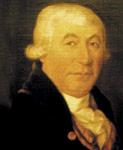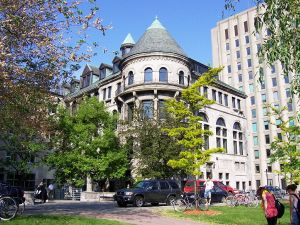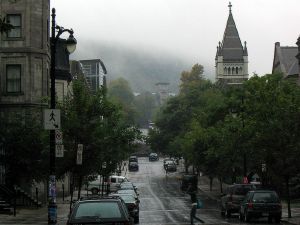McGill University
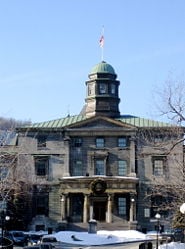
| |
| Motto | Grandescunt aucta labore<br\>(By work, all things increase and grow) |
|---|---|
| Established | 1821 |
| Type | Public university |
| Location | |
| Website | www.mcgill.ca |
McGill University is a publicly funded, co-educational research university located in the city of Montreal, Quebec, Canada. McGill's main campus is set upon 320,000 square metres (80 acres) at the foot of Mount Royal in Montreal's downtown district. A second campus—Macdonald Campus—is situated on 6.5 square kilometres (1,600 acres) of fields and forested land in Sainte-Anne-de-Bellevue, 30 kilometres west of the downtown campus. McGill has 21 faculties and professional schools and offers degrees and diplomas in over 300 fields of study. The university also has field research stations in Mont-Saint-Hilaire and Schefferville, Quebec; Axel Heiberg Island in Nunavut; and Holetown, Barbados.
McGill was founded in 1821 from a bequest by James McGill, a prominent Montreal merchant, who left an endowment in addition to the property on which the university now stands. McGill would become the first non-denominational university in the British Empire.
McGill's Redpath Museum, commissioned in 1880 and opened in 1882, is the oldest building built specifically as a museum in North America. Its natural history collections boast material collected by the same individuals who founded the collections of the Royal Ontario Museum and the Smithsonian.
History
The Royal Institution for the Advancement of Learning
The Royal Institution for the Advancement of Learning (R.I.A.L.), McGill's corporate personality, was created in 1801 by an Act of the Legislative Assembly of Lower Canada, which called for the "Establishment of Free Schools and the advancement of Learning in this Province."[1] The institution's initial purpose was to administer the provision of elementary education in Quebec, but the R.I.A.L. spent most of its early years trying to get funds from the government to enable it to establish and operate these schools, which were primarily for the Protestant English-speaking inhabitants of Lower Canada (now largely comprising modern-day Quebec). The R.I.A.L. was the first institution in Canada to receive royal patronage.
In 1811, James McGill, a Scottish immigrant and successful English- and French-speaking merchant, drew up a will leaving a 19 hectare (46 acre) tract of land—his estate, which he called Burnside—in what was then rural land. In addition, he bequeathed the sum of 10,000 pounds to the R.I.A.L. As a condition of the bequest, the land and funds would have to be used for the establishment of a "University or College, for the purposes of Education and the Advancement of Learning in the said Province."[1] When he died in December 1813, this task became the responsibility of the R.I.A.L. The will specified that, if a college was not established within 10 years of his death, the estate and the money would revert to the heirs of his wife, Charlotte Desrivieres. As an added condition, the new institution would be required to bear his name.
In 1821, after protracted legal battles with the Desrivieres family, McGill College received a Royal Charter from King George IV, establishing it as a university. In fact, due to the lawsuits—which did not finally end until 1835—and because the college had little money (the government was not funding the institution at the time), classes were not held until 1829, when McGill College was officially inaugurated. That same year, the Montreal Medical Institution became the college's Faculty of Medicine and its first academic unit. The Faculty of Medicine remained the college's only functioning faculty until 1843 when the Faculty of Arts commenced teaching in the newly constructed Arts Building and East Wing (Dawson Hall).
In due course, the R.I.A.L. lost control of the 84 grammar schools it had administered. At that point, its sole purpose was to administer the McGill bequests on behalf of the college. The Royal Institution for the Advancement of Learning continues to exist and is the "legal person" that runs the university and its various constituent bodies, including the former Macdonald College (now Macdonald Campus), Royal Victoria College (the former women's college turned residence) and the Montreal Neurological Institute. The Institution's name appears on all cheques cut by the university. The Trustees of the Royal Institution for the Advancement of Learning comprise, since the revised Royal Charter of 1852, the Board of Governors of McGill University.[2]
Early years
The first classes were held in Burnside Place, James McGill's country home, until the 1840s when the university began construction on its first buildings, the central and east wings of the Arts Building.[3] However, the rest of the campus was essentially a cow pasture. Sir John William Dawson, McGill's fifth principal (from 1855 to 1893) is often credited with transforming the school into a modern university.[4] He recruited the aid of Montreal's wealthiest citizens, many of whom donated the property and funding needed to construct the campus' buildings. Their names adorn many of the campus's prominent buildings including the Redpath Museum (1880), Macdonald Physics Building (1893), the Redpath Library (1893), the Macdonald Chemistry Building (1896), the Macdonald Engineering Building (1907), and the Strathcona Medical Building (1907 - now the Strathcona Anatomy and Dentistry Building). This expansion of the campus continued through to 1920. In 1885, the university's Board of Governors formally adopted the use of the name McGill University.
Women's education at McGill began in 1884 when Donald Smith, also known as Lord Strathcona, began funding separate lectures for women, given by university staff members. The first degrees granted to women at McGill were conferred in 1888.[5] Later, in 1899, the Royal Victoria College (RVC) opened as a residential college for women at McGill. Until the 1970s, all female undergraduate students, known as "Donaldas," were considered to be members of RVC.[6] Today, the College is an all-women's dormitory forming part of the university's residence system.
In 1905, the university acquired a second campus when Sir William C. Macdonald, one of the university's major benefactors, endowed a college in Sainte-Anne-de-Bellevue, 32 kilometres west of Montreal. Macdonald College, now known as the Macdonald Campus, opened to students in 1907, originally offering programs in agriculture, household science, and teaching.
McGill established the first post-secondary institutions in British Columbia, to provide degree programs to the growing cities of Vancouver and Victoria. It created Victoria College in 1903, a two-year college offering first- and second-year McGill courses in arts and science, which was the predecessor institution to the modern University of Victoria. The province's first university was incorporated in Vancouver in 1908 as the McGill University College of British Columbia. The private institution granted McGill degrees until it became the independent University of British Columbia in 1915.[7]
McGill français movement
The 1960s represented an era of large nationalist and labour mobilizations in Quebec. At the time, English was seen as the privileged language of commerce, and McGill, with francophones comprising only three percent of the student population, was seen by some as a bastion of anglophone privilege in a predominantly French-speaking city.[8][9] In addition, there was only one French-language university in Montreal at the time: the Université de Montréal. McGill was largely out of reach to the 10,000 francophone graduates of the newly-created CEGEP system who had nowhere else to go, locally, to continue their studies, and almost no other French-speaking university to go to in Canada.
The McGill français movement began in 1969, clamouring for a new McGill that would be francophone, pro-nationalist, and pro-worker. The movement was led by Stanley Gray, a political science professor from Ontario. It was argued that, since McGill received the lion's share of government funding, paid by a taxpayer base that was largely francophone, the university should equally be accessible to that segment of the population. Gray led a demonstration of 10,000 trade unionists, leftist activists, CEGEP students, and even some McGill students, at the university's Roddick Gates on March 28, 1969, with protesters shouting McGill français, McGill aux Québécois, and McGill aux travailleurs (McGill for workers). However, the majority of students and faculty opposed such a position, and many of the protesters were arrested.[10][11]
McGill never became a francophone or bilingual university. However, francophones now make up approximately 20 percent of the student body, a goal set by the administration in the wake of the movement.[12]
Language of instruction
McGill is one of three English-language universities in Quebec (the others being Concordia University, also in Montreal, and Bishop's University in Lennoxville); fluency in French is not a requirement to attend. The Faculty of Law does, however, require all students to be "passively bilingual," meaning that all students must be able to read and understand spoken French, or English if the student is Francophone, since English or French may be used at any time in a course. Since 1964, students in all faculties have been able to write exams and papers in either English or French, provided that the objective of the class is not to learn a particular language.[13]
Academics
Profile
McGill's student population includes, both full-time and part-time, 23,758 undergraduate and 7,323 graduate students in over 340 academic programs in eleven faculties (as of 2007-2008). Its students represent a diverse geographic and linguistic background. Of the entire student population, 57.3% are from Quebec, while 23.7% come from the rest of Canada, and 19.0% are international. As their mother tongue, 52.8% of all students speak English, while 18.1% speak French, and 29.1% speak a language other than English or French.
About 90% of students ranked in the top 10% of their high school graduating class.[14] McGill has produced 128 Rhodes Scholars, more than any other Canadian university, as well as seven Nobel Laureates.[15]
Nearly 30% of all students are enrolled in the Faculty of Arts, McGill's largest academic unit. Of the other larger faculties, the Centre for Continuing Education enrolls 13%, the Faculty of Science enrolls 14%, and the Faculty of Engineering enrolls 10%. The Desautels Faculty of Management enrolls 10%, and the Faculty of Medicine enrolls 12%. The remainder of all students are enrolled in McGill's smaller schools, including the Faculty of Agricultural and Environmental Sciences, Faculty of Dentistry, Faculty of Education, Faculty of Law, Schulich School of Music, and the Faculty of Religious Studies.
Comprising nearly 20% of the university's student body, international students are a significant presence on the McGill campus. The plurality of McGill's international students are from the United States, making up 37% of all international students and 49% of all undergraduate international students.[14] A growing number of American students are attending McGill, with such students representing 9.7% of all undergraduates and 6.9% of all students at the university.[14] Many are attracted to the culture and dynamism of Montreal, the university's reputation, and the relatively low tuition in comparison to many top public and private universities in the United States.[16] However, this trend is being repeated at many other Canadian universities, particularly those close to the Canada/U.S. border. In turn, many Canadian universities, including McGill, are stepping up their recruitment efforts at U.S. high schools.[17]
Since 1996, McGill, in accordance with the Ministère de l'Éducation, du Loisir et du Sport (MELS), has had eight categories qualifying certain international students an exemption from paying international fees. These categories include students from France, a quota of students from select countries which have agreements with MELS (including Algeria, China, and Morocco)[18], students holding diplomatic status (and their dependants), and students enrolled in certain language programs leading to a degree in French.[19]
There are nearly 1,600 tenured or tenure-track professors, plus another 4,300 adjunct and visiting professors teaching at the university.[20] McGill consistently leads the rest of Canada in terms of research dollars per full-time faculty member and number of refereed publications per full-time faculty member. According to a study by Research Infosource, research funding represents approximately $259,100 per faculty member, the fourth highest in the country.[21] Overall, in 2007, Research Infosource ranked McGill the second-best research university in the country, after the University of Toronto.[22] McGill also has one of the most per faculty research dollars nationwide from federal and provincial sources of funding (including the Canada Foundation for Innovation and the Natural Sciences and Engineering Research Council).
McGill professors have won 26 Prix du Québec, 14 Prix de l'Association francophone pour le savoir and 13 Killam Prizes.
Rankings
McGill is Canada's top-ranked medical-doctoral university, ranking first in Canada for the third consecutive year in the Maclean's 17th annual University Rankings issue.[23] The university has held first place in student awards for nine consecutive years, and consistently ranks first for reputation and average size and number of social sciences/humanities grants per full-time faculty.[24]
In the THES - QS World University Rankings 2007, McGill University was ranked the best public university in North America, 8th overall in North America, and 12th in the world.[25][26] In the world, McGill ranked 26th in the natural sciences, 10th in the life sciences and biomedicine, 27th in technology, 12th in the social sciences, and 12th in the humanities.[25] This achievement has been regarded as the "highest rank to be reached by a Canadian institution."[27]
Shanghai Jiao Tong University, in its Academic Ranking of World Universities 2007, ranked McGill third in Canada, 44th in the Americas, and 63rd in the world.[28][29]
In 2006, Newsweek also ranked McGill third in Canada, 30th in North America, and 42nd worldwide.[30]
McGill is a member of the Association of American Universities (AAU), an organization of research-intensive universities in North America. It is also a member of Universitas 21, an international association of research-driven universities. In addition, it is a member of the G13, a group of prominent research universities in Canada.
Admissions
According to the Admissions, Recruitment and Registrar's Office, McGill admitted 46% of undergraduate applicants and 38% of graduate applicants for the entering class in Fall 2007.[31] The median high school average for the entering undergraduate class was 90% for Canadian students (89% for students in Ontario and 91% for students from other provinces) and a 3.7/4.0 GPA for American students.[31] The median SAT scores for verbal, math, and writing were 690, 680, and 690, respectively, and the median ACT score was 30.[31] The median Quebec CEGEP r-score was 30.13.[31]
McGill's entering class has the highest average entering grades in Canada.[32]
Research
McGill is ranked fourth in Canada in research-intensity and total-research funding[21], and is recognized as one of the top research universities in Canada and was named "Research University of the Year" by Research Infosource in its 2003 and 2005 ranking of Canada's Top 50 Research Universities.[33][22] Researchers and scientists at the university are affiliated with nearly 100 research centres and networks.
The university is perhaps best recognized for its research and discoveries in the health sciences. William Osler, Wilder Penfield, Donald Hebb, Brenda Milner, and others made significant discoveries in medicine, neuroscience and psychology while at McGill. The invention of the world's first artificial cell was made by an undergraduate student at the university. As chair of physics at McGill, nuclear physicist Ernest Rutherford performed the experiment that led to the discovery of the alpha particle and its function in radioactive decay, which won him the Nobel Prize in Chemistry in 1908. Similarly, William Chalmers, invented Plexiglas while a graduate student at McGill.[34]
In terms of contributions to computing, MUSIC/SP, a piece of software for mainframes once popular among universities and colleges around the world at its time, was developed at McGill. A team also contributed to the development of Archie, one of the pre-WWW search engines. A 3270 terminal emulator developed at McGill was commercialized and later sold to Hummingbird Software.
McGill's Bellairs Research Institute, in Barbados, serves as Canada's only teaching and research facility in the tropics. These facilities are used by the Canadian Space Agency for research.
Campus
The main campus is situated in downtown Montréal at the foot of Mount Royal. Most of the buildings are situated in a park-like campus north of Sherbrooke Street and south of Avenue des Pins between Peel and Aylmer streets. North of Docteur-Penfield, it also extends west of Peel for several blocks. The campus is near the Peel and McGill metro stations.
The downtown campus reflects an eclectic mix of old and new buildings, reflecting the various periods in which the buildings were erected and a variety of architectural styles. All of the major university buildings were constructed using local grey limestone, which serves as a unifying element.
The university's athletic facilities, including Molson Stadium, are located on Mount Royal, near the residence halls and the Montreal Neurological Institute. The Gymnasium is named in honour of General Sir Arthur William Currie.
A second campus, the Macdonald Campus, in Sainte-Anne-de-Bellevue houses the Faculty of Agricultural and Environmental Science, the School of Dietetics and Human Nutrition, the Institute of Parasitology and the McGill School of Environment. The Morgan Arboretum and the J. S. Marshall Radar Observatory are nearby.
There are plans to consolidate the various hospitals of the McGill University Health Centre on the site of an old CP railyard adjacent to the Vendôme metro station. This site, known as Glen Yards, comprises 170,000 square metres (43 acres) and spans portions of Montreal's Notre-Dame-de-Grâce neighborhood and the city of Westmount.[35] The Glen Yards project has been fraught with controversy due to local opposition to the project, environmental issues, and the cost of the project itself.[36] The project, which has received approval from the provincial government, is expected to be complete by 2010.[37]
Student life
Residential life
Unlike other large schools, most McGill students do not live in residence (known colloquially as "rez") after their first year of study, even if they are not from the Montreal area. This is due to Montreal's cheap rent and the fact that McGill's residence system is relatively small for a school of its size, housing approximately 2,400 undergraduate students and a handful of graduate students.[38] With the exception of upper year students returning as "floor fellows," the majority of McGill residences are for first-year undergraduate students only. Upper-year students are expected to find off-campus housing.
Residences at McGill come in a variety of forms. Most first-years live in Upper Rez, a series of dormitories on the slope of Mount Royal, consisting of Douglas Hall, McConnell Hall, Molson Hall and Gardner Hall. Royal Victoria College, once a women's college affiliated with McGill, is a dormitory for women and is the closest to campus. McGill's newest residence, aptly named New Residence Hall (colloquilly New Rez) was converted from a four-star hotel and is perhaps the most luxurious of the residences at McGill. Solin Hall, an apartment-style residence four metro stops from campus, is the farthest from campus. The university also maintains apartment style housing around campus.
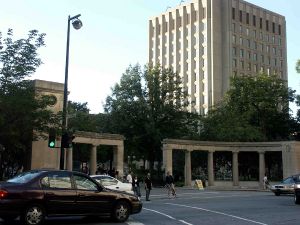
Second-year students are expected to transition to off-campus apartment housing, and apartment hunting is sometimes seen as a "rite of passage" for McGill students. In recent years, finding affordable housing has been challenging because of the city's tight housing market, particularly in neighbourhoods close to the McGill campus. Many students end up living in the "McGill Ghetto," the neighbourhood directly to the east of campus, although students have, in recent years, begun moving out to other areas because of rising rent prices in the "Ghetto."
Activities
There are hundreds of clubs and student organizations at the university. Many of them are centred around McGill's student union building—the University Centre—known unofficially as the Shatner Building. In 1992, students held a referendum and named the building after actor and McGill alumnus William Shatner, although the university administration refuses to accept the name and did not show up for the opening. Traditionally, the administration names buildings in honour of deceased members of the university community or for major benefactors—and Shatner is neither.[39][40]
McGill has two English-language student-run newspapers: the McGill Daily, which is a financially independent publication, and the McGill Tribune, which is published through the Students' Society of McGill University. The Délit français is the Daily's French-language counterpart. CKUT (90.3 FM) is the campus radio station. TVMcGill is the University TV station, broadcasting on closed-circuit television and over the internet.[41]
Student representation
The campus has an active students' union represented by the undergraduate Students' Society of McGill University (SSMU) and the Post-Graduate Students' Society of McGill University (PGSS). In addition, each faculty has its own student governing body.
Athletics
The university is represented in Canadian Interuniversity Sport by the McGill Redmen (men's) and the McGill Martlets (women's).
McGill maintains a friendly rivalry with Queen's University in Kingston, Ontario. Animosity between rowing athletes at the two schools has inspired an annual boat race between the two universities in the spring of each year since 1997. This academic and athletic rivalry, which was once very intense, waned after Queen's pulled their football team out of the Ontario-Quebec Intercollegiate Football Conference in 2000 but the intensity returned in 2002 and transferred to the annual home-and-home varsity hockey games between the two institutions. Nevertheless, the two share a successful publishing house (McGill-Queen's University Press). The school also competes in the annual "Old Four" soccer tournament, with Queen's, the University of Toronto and the University of Western Ontario.
The inventions of North American football, hockey, and basketball are all related to McGill in some way. The first game of North American football was played between McGill and Harvard in 1874. The world's first organized hockey club (known as the Redmen since 1927), played their first game on January 31, 1877. McGill alumnus James Naismith invented basketball in early December of 1891.[42]
There has been a McGill alumnus or alumna competing at most Olympic Games since 1912. Gold medallists include swimmer George Hodgson—winner of two gold medals—at the 1912 Summer Olympics in Stockholm, ice hockey goaltender Kim St-Pierre— also a winner of two gold medals—at the 2002 Winter Olympics in Salt Lake City, and at the 2006 Winter Olympics in Turin, where recently, Jennifer Heil (a current student) was a gold medallist in the women's freestyle mogul event and goaltender Charline Labonté (also a current student) helped Canada win gold in women's ice hockey.
In 1996, the McGill Sports Hall of Fame was established to honour its best student athletes. Notable members of the Hall of Fame include James Naismith and Sydney Pierce.
Hazing scandal
McGill's Redmen football program was rocked by a hazing scandal in 2005 forcing the cancellation of the final two games of the season by school officials. A formal investigation into the hazing scandals showed that "the event did involve nudity, degrading positions and behaviours, gagging, touching in inappropriate manners with a broomstick, as well as verbal and physical intimidation of rookies by a large portion of the team."[43] Dubbed 'Hazegate' by the local Montreal Gazette, the scandal made national news. In 2006, McGill's Senate approved a proposed anti-hazing policy to define forbidden initiation practices.[44]
Symbols
The university's symbol is the martlet, stemming from the presence of the mythical bird on the official Arms of the university. Inscribed on its arms is also In Domino Confido (I trust in the Lord), James McGill's personal motto.
The University's patent of arms was granted by England's Garter-King-at-Arms in 1922 and registered in 1956 with Lord Lyon King of Arms in Edinburgh and in 1992 with the Public Register of Arms, Flags and Badges of Canada. In heraldic terms, the arms are described as follows:
Argent three Martlets Gules, on a chief dancette of the second, an open book proper garnished or bearing the legend In Domino Confido in letters Sable between two crowns of the first. Motto: Grandescunt Aucta Labore.
The school song is entitled "Hail, Alma Mater." The lyrics to the song are:
Hail, Alma Mater, we sing to thy praise;
Loud in thy Honour, our voices we raise.
Full to thy fortune, our glasses we fill.
Life and Prosperity, Dear Old McGill.
Hail, Alma Mater, thy praises we sing:
Far down the centuries, still may they ring.
Long through the ages remain — if God will,
Queen of the Colleges, Dear Old McGill.
An audio recording of "Hail, Alma Mater," as well as other McGill University songs, is available on the McGill University Archives website.
McGill's motto is Grandescunt Aucta Labore, Latin for "by work, all things grow." Its official colours are red and white.
Battle honours
Battle Honours are awarded to regiments of the British Empire to commemorate their participation in battles. On only two occasions have they been awarded to educational institutions. On the first occasion they were awarded to La Martiniere College in Lucknow and secondly to the McGill University contingent for their bravery at Arras in 1917 during the First World War.[45]
Notable alumni and faculty
The faculty and alumni of the university include seven Nobel Prize winners, 1 Templeton Prize winner[46], 128 Rhodes Scholars[15], 1 Pulitzer Prize winner[47], and 7 Academy Award winners[48]. In addition, McGill is the alma mater of two Canadian prime ministers and several Supreme Court of Canada justices[49] and Canadian Ministers of Justice.
ReferencesISBN links support NWE through referral fees
- ↑ 1.0 1.1 The Royal Charter of McGill University, accessed January 21, 2006.
- ↑ Frost, Stanley Brice. McGill University, Vol. I. For the Advancement of Learning, 1801-1895. McGill-Queen's University Press, 1980. ISBN 978-0-7735-0353-3
- ↑ The Early Campus, Virtual McGill.
- ↑ [1]
- ↑ William Dawson, CCHeritage.
- ↑ Royal Victoria College, McGill University Archives.
- ↑ Higher Education in British Columbia Before the Establishment of UBC, UBC Archives.
- ↑ [2]
- ↑ [3]
- ↑ Chester, Bronwyn. "McGill français and Quebec society". McGill Reporter, April 8, 1999. Accessed on January 20, 2006.
- ↑ Provart, John. McGill français 30 years later. McGill News, Summer 1999.
- ↑ McGill Facts 2004-2005
- ↑ [4]
- ↑ 14.0 14.1 14.2 Enrolment reports. McGill University. Retrieved 2007-11-17.
- ↑ 15.0 15.1 Introduction to McGill. McGill University.
- ↑ Bauer, Andrew. "NEWS ANALYSIS: Americans love McGill". McGill Tribune, October 26, 2004.
- ↑ CNN.com. "College costs push Americans to Canada". October 4, 2002.
- ↑ Countries and International Organizations Granted Exemptions from the Additional Financial Contribution by the Government of Quebec, Ministère de l'Éducation, du Loisir et du Sport.
- ↑ International Fee Exemption
- ↑ Cite error: Invalid
<ref>tag; no text was provided for refs namedfacultystaff - ↑ 21.0 21.1 Top 50 Research Universities List. Research Infosource.
- ↑ 22.0 22.1 Research Universities of the Year 2007. Research Infosource.
- ↑ http://www.mcgill.ca/newsroom/news/?ItemID=27863
- ↑ http://www.mcgill.ca/newsroom/news/?ItemID=27863
- ↑ 25.0 25.1 2007 THES-QS World University Rankings. THES-QS.
- ↑ McGill tops on continent: global survey. The Gazette.
- ↑ McGill takes 12th spot in global ranking. The Globe and Mail.
- ↑ Top 500 World Universities. Institute of Higher Education, Shanghai Jiao Tong University.
- ↑ Top 100 North & Latin American Universities. Institute of Higher Education, Shanghai Jiao Tong University.
- ↑ The Top 100 Global Universities. Newsweek.
- ↑ 31.0 31.1 31.2 31.3 Admissions Profile. McGill University. Retrieved 2007-10-01.
- ↑ Cite error: Invalid
<ref>tag; no text was provided for refs namedstudents - ↑ Zeindler, Christine. "McGill is research university of the year, tops in Times". McGill Reporter, October 27, 2005.
- ↑ http://www.mcgill.ca/facts2005-06/alumni/
- ↑ This Land Was Made for You and Me..., McGill University Health Centre Journal, July/August 2001.
- ↑ McCabe, Daniel. MUHC site chosen, McGill Reporter, November 5, 1998.
- ↑ Reynolds, Mark. Green light on Glen Yards, McGill Reporter, September 11, 2003.
- ↑ McGill Residences
- ↑ Stojsic, Leslie. "The trek back home". McGill Reporter, March 11, 1999.
- ↑ History of the SSMU
- ↑ TVMcGill
- ↑ Athletics, Viewbook 2005-2006.
- ↑ "McGill University cancels football season," McGill University Press Release, October 19, 2005. Available online at http://www.football.mcgill.ca/mediaroom/2005/10_19_2005.php
- ↑ McGill get tough with hazing. The Globe and Mail, 11 Jan. 07. Caroline Alphonso.
- ↑ McGill University at regiments.org accessed July 2007
- ↑ http://www.mcgill.ca/reporter/39/13/taylor/
- ↑ http://www.postwritersgroup.com/krauthammer.htm
- ↑ http://www.mcgill.ca/facts2005-06/alumni/
- ↑ http://www.mcgill.ca/facts2005-06/alumni/
External links
| Association of American Universities | |
|---|---|
| Public | Arizona • Buffalo (SUNY) • UC Berkeley • UC Davis • UC Irvine • UCLA • UC San Diego • UC Santa Barbara • Colorado • Florida • Illinois • Indiana • Iowa • Iowa State • Kansas • Maryland • Michigan • Michigan State • Minnesota • Missouri • Nebraska • North Carolina • Ohio State • Oregon • Penn State • Pittsburgh • Purdue • Rutgers • Stony Brook (SUNY) • Texas • Texas A&M • Virginia • Washington • Wisconsin |
| Private | |
| Canadian | McGill • Toronto |
